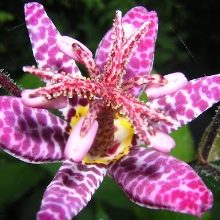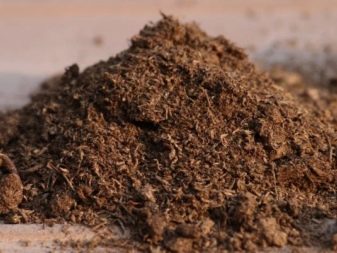What is tricyrtis and how to grow it?

Tricirtis is a beautiful perennial plant of the lily family, similar to an orchid. The country of origin is Japan, it also grows throughout East Asia, in the Himalayas and Taiwan. The article will discuss what types and varieties of tricyrtis exist, as well as all the intricacies of its cultivation.


general description
The genus of tricyrtis is not numerous; it includes only about 15 species. In a literal translation from Greek, the name of the daylily means "three tubercles" - according to the number of nectaries, the common name of the plant among flower growers is "toad lily". It is also called a garden orchid.
The color of the petals is spotty, speckled, similar to the plumage of a bird. The stems are cylindrical in shape, reaching a length of 50 to 80 cm, can be straight or slightly branched in the upper part. The leaves and the shoots themselves are pubescent. An interesting fact - the leaves of tricyrtis have the same spotted, patterned colors as the flower petals, but less bright. The shape of the leaves is oblong, oval. The root system of the plant is shallow, superficial, and does not tolerate transplanting well.


Tricirtis begins to bloom in early June. The flowers are 2–4 cm in diameter and consist of 6 petals. Inflorescences are either single or in the form of a brush or umbrella. Flowers are located on top of the shoot itself or in the axils of the leaves. Their colors can be completely different, it depends on the variety and type of flower - monochromatic, speckled, spotted. The peculiarity of the plant is such that boxes with small seeds can ripen on it, which are then used for reproduction.


Popular species and varieties
There are many species and varieties of this exotic daylily. It is worth understanding the features of the most popular options to make it easier to make the best choice for decorating your garden. Most of the tricyrtis species are thermophilic, but there are also cold-resistant ones that can withstand sharp drops in temperature.

Yellow
This flower has a yellow color, more often it is monochromatic, sometimes there are brown, barely noticeable specks on the petals. The flower petals are quite wide. Plant height varies from 25 to 40 cm. Stems are most often straight, but there are also branchy. The flower is considered rustic due to its small size and normal color. However, this species is distinguished by frost resistance and unpretentiousness, therefore, it may not take the last place in the garden.
You can plant yellow tricyrtis in groups in near-trunk circles under the trees, it will look great there.

Taiwanese
This type of tricyrtis is the most famous and demanded among amateur flower growers. This is a tall daylily, the stem length reaches 80 cm. The stems are completely covered with villi, velvety to the touch. The leaves, on the other hand, are glossy and very bright. The flowers are also large, white with purple dots. The lip of the flower is painted in a bright burgundy color and looks like a pod divided into three branches at the end. A worthy representative of this species will take pride of place in your flower garden.

Long-legged
The height of this type of tricyrtis does not exceed 70 cm; lower plants are also found - up to 40 cm. The buds are white in color, red and purple blotches. The stem is slightly pubescent, cylindrical. Leaves are oval or oblong in shape.The colors are harmonious and the plant looks very attractive.

Hairy
This representative of the genus Tricyrtis is very unusual. The stem itself, as you might guess, is covered with hairs and is colored blue. The buds are also unusual - white with dots of dark pink, which become light pink closer to the middle. The uniqueness of the flower is complemented by a green lip, below it is covered with small purple specks. It is crowned with three nectaries, which appear even before the flowers themselves.

Broadleaf
This is one of the most frost-resistant species of tricyrtis. The height of the straight stem is 60 cm. It is completely covered with oval, wide leaves. This daylily is good for group planting. The flowers are creamy or yellowish, monochromatic, almost without blotches, collected in inflorescences. Tricyrtis blooms early - at the end of May, and flowering continues until October.

Short-haired
Another name for the species is hirta. The homeland of the plant is the Japanese subtropics. This type is the most widespread and well-known. Differs in particular endurance to difficult weather conditions. The height of the branched stems is 60–80 cm. The leaves are oblong, and the flowers are white with purple dots, small in size. This tricyrtis is considered one of the most attractive. The leaves have almost no lint.

By the way, all of the above species - Taiwanese, hairy, long-legged, as well as such a species as stoliferous - are close in characteristics and appearance to short-haired. Popular varieties of tricirtis:
- "Purple beauty" - the variety has white flowers, completely dotted with bright red specks;
- Blue wonder - the height of the variety is 60 cm, the leaves are wide enough, with a short nap, the plant loves shade, very unpretentious, but for the winter it is better to cover it a little, the flower is beautiful in group plantings, next to hosts and ferns, white flowers with purple spots, with a diameter of 2 up to 4 cm;
- "Dark beauty" - the variety has pinkish flowers with red spots.



Landing nuances
Despite the fact that many types of tricyrtis are hardy, in those regions where early frosts are frequent, flowering does not begin until mid-summer. If you want to extend the flowering period as long as possible, plant these plants in deep pots and tubs. If September is usually warm in your area, feel free to plant tricyrtis in open ground. These daylilies prefer partial shade and grow well under trees. Tricirtis loves soil similar in composition to forest soil - soil with rotted leaves, peaty, does not tolerate stagnant water. The garden area should be protected from drafts and winds.


Care features
Plant care in the open field is not difficult at all. With the right choice of a site for growing tricyrtis, care comes down to the following activities:
- timely watering of the plant, especially in drought, the soil near the flower must be constantly moistened;
- loosening the soil, especially after watering;
- weeding;
- feeding flowers several times per season - using humus, complex mineral fertilizers;
- removal of dried flowers.


Let us consider in more detail the features of watering a plant.
Although tricyrtis is considered a drought tolerant crop, but still loves timely, fairly frequent watering. It is good if soft water is used for irrigation, and even better - settled rainwater. Water the plant at the root, avoiding the leaves. Loosen after watering. To retain moisture, you can mulch the soil under the plant.
Tricirtis is not picky about frequent transplants. It can grow well in one place, provided that you regularly feed and water the plant.
Experience shows that these plants need to be covered for the winter. Some gardeners use agrofibre for this. But the best option is to cover the bushes with a good layer of peat. Then your exotics will winter well and will not freeze.


Reproduction methods
The garden orchid reproduces in several ways - by seeds, dividing the bush and cuttings. Reproduction by seeds is a rather lengthy process, it requires patience, because flowering will come only after a few years.
- The seeds are harvested in the fall and immediately sown at the planned permanent location.
- The prepared area is loosened, the seeds are sealed to a depth of only 3 mm and slightly moistened.
- If you plan to sow tricyrtis in the spring, then the seeds should be stored in the refrigerator.
- Plants obtained from seeds will please with flowering only for 2-3 years.

If there is a need to transplant a plant, then gardeners use reproduction by dividing the bush. It is better not to disturb tricyrtis without the need - because of the fragility of the root system, it does not tolerate a transplant well.
- This procedure should be carried out in the spring.... Take a sharp instrument. When the plant is dug out, carefully divide the bush into several divisions.
- Prepare planting holes in advance, pour humus or leafy earth into them, spill with water.
- Plant the plants in a new location and pour again.

Often, gardeners also use cuttings.
Tricyrtis is able to easily give new growth even from a small root fragment. In the spring, a separated basal cutting is added in a new place, it will definitely take root.
Daylily reproduces well with the help of stem cuttings. To do this, in the summer, cuttings are cut from the stems of this year and planted in a new place in a peat-sand mixture.
Cuttings should be constantly moistened, sprayed.

Diseases and pests
Tricyrtis is quite resistant to diseases and pests. The main problem is that plants love to attack slugs. Pick them by hand or you can sprinkle eggshells near the plants. She will injure crawling pests and thereby scare away.
Rarely, but sometimes tricyrtis infects spider mites. To combat it, you will have to use insecticides.
It is also important to beware of over-watering daylilies - root decay may occur.... As with anything, stick to the middle ground. Water the plant as needed, but don't overfill.

Try to plant a magnificent tricyrtis in your garden, and you will definitely get a lot of pleasure both from the growing process and from the wonderful flowering of this exotic.







































































































The comment was sent successfully.